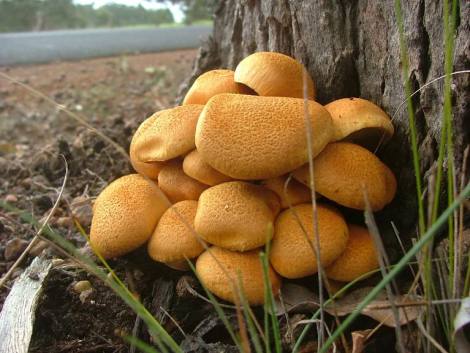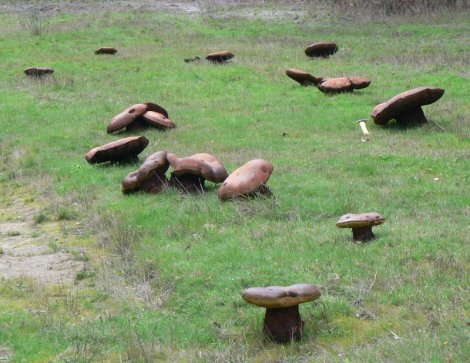Gymnopilus junonius is also known as Gymnopilus spectabilis according to some sources (Arora p 411 for example) and I am assuming that equivalence in much of the discussion that follows. It is also known and Big Laughing Gym, since there are reports of the species being hallucinogenic. However, it is more likely that it has been confused with another species of the same genus. Either that, or the chemistry varies a lot (and in fact there are sources which suggest such regional variation in the chemistry). Bettye Rees, an Australian authority on the genus, describes it as a cosmopolitan species (6). She does not equate it with G. spectabilis though, but with G. pampeanus.
This fungus is extremely common in Autumn in my part of the world, forming huge clumps on the base of dying trees and old stumps. It occurs widely across the continent and Rees even suggests that it may be an import due to its presence on pine stumps. I have seen it both on pine stumps and at the base of marri trees. Apart from the reports of hallucinogenic activity, the species is not considered to be poisonous. The dominant feature to anyone who tastes this mushroom is its extreme bitterness. It is seriously unpleasant! Nobody with any sense of taste could possibly consume these, even if desperate for some thrill.
A little bit of experimentation however reveals that the unpleasant bitter taste can be removed by washing with vinegar and probably any other food acid. By contrast, sodium bicarbonate does not remove the bitter taste. This simple experiment reveals that the taste is acid soluble.
Given the knowledge gained from this experiment, I prepared some strips of the mushroom, leached them twice with vinegar and then rinsed with water. The result was something that retained some vinegar taste but was free of the horrible bitterness. I consumed a small portion without ill effect, or hallucinations! So, I put this mushroom forward a possible food.
As with everything, one would need to be very sure of identification before proceeding with this. And any experimentation should be undertaken with caution, but I see some possibilities.
Further notes 28 June 2012
My background in chemistry has caused me to become intrigued with this mushroom. I have done some more research and find an amazing array of conflicting statements, first hand experiences and views on chemistry.
The first thing is that this species does appear to have been responsible for various hallucinogenic experiences and reports of this range from traditional Japanese sources (1), to present day forums that discuss these things. It is said that the mushroom is consumed by people in Oguni in Yamagata prefecture, a mountainous area in Japan without ill effect when the bitter components are removed by boiling in water. (2). The fact that the mushroom is mentioned from traditional Japanese stories, as well as the comment that it is eaten today makes the history of Japanese consumption an interesting topic. It may well have been eaten for a thousand years in Japan. Kusano’s comment “Some people have described intoxication as a result of accidental ingestion of incorrectly cooked mushrooms” is an interesting comment, as it would be hard to eat them if the bitterness was not removed.
There are many sources that say this mushroom contains psilocybin, but many more that refute that. I cannot find any reports in peer-reviewed journals of isolation of that chemical from this species. It seems much more likely that the presence of that component has been inferred or simply claimed without due diligence (3) and many others.
Correction 23/02/2013: There is a report of psilocybin in this genus, including G. spectabilis, which is another name for this mushroom. The levels are low though.
Other literature sources report and discuss the presence of bis noryangonin and compare these to the components of kava to account for the observed activity. This may be the case, but one might expect the resultant experience to be mild. Rees reports the presence of hispidin and bis-noryangonin in many but not all specimens of the genus in Australia. These are responsible for the yellow colour that has allowed the mushroom to be used to dye fabric.
Yet another explanation of the effects of the mushroom attribute it to the bitter principles, gymnopilins, that are said to have neurotoxic effects. (4). I have a copy of this last paper and the striking thing from my point of view is that the components that they examine are ones that are in the acidic fraction, which is the one we would expect to extract with a solution of sodium bicarbonate. We would not expect these to be extracted by vinegar. It brings me to wonder if they have actually proven that they are examining the bitter principle. There is no mention of taste tests. Their initial extraction with methanol may leave a mushroom devoid of bitterness (it does), but they do not report on the bitterness of subsequent fractions. (see below, however comments on bitter principle 3 April 2023)
So, I caution the reader. The chemistry is not well-defined. The source of any psychotropic effects has three explanations, none of which may be correct. For the moment, I can only report my experience which is that the bitter taste can be removed with vinegar and small portions of the resulting mushroom are edible and non-toxic.
Further tests involving boiling and (acid leaching followed by alkaline leaching) are indicated. This may take years. It is a very interesting exploration though.
References to follow.
Further note 24 July 2012
I found a large specimen and cut off a quarter of the cap and boiled it in about a litre of water for 5 minutes. I then removed the piece and rinsed it with cold water. Tasting revealed that the boiling process had indeed removed the bitter taste from the mushroom. Further tasting revealed that the bitter principle had been transferred to the water broth, which had taken on a rusty orange colour.
Perusal of a forum dedicated consumption of psychotropic mushrooms (5) indicates that people consume the bitter ‘tea’ made from the mushrooms to get intoxicated, so that is further support that the leached mushrooms should not cause any ill effects.
August 2015
This year I tried slicing one of these mushrooms thinly and boiling it extensively for an hour. I then fried the resulting pieces. The bitter taste was still there. I can’t really much hope of rendering these things into anything taste-worthy.
May 2016
Even if you can’t eat these, they may be useful in another way. According to the book ‘Mushrooms for color’ by Miriam C. Rice, they can be used with or without mordants to create dyes for fabrics. The fresh mushrooms without mordant give a bright lemon yellow. Dried ones give pale lemon yellow with all mordants except tin which gives mustard. Fresh ones with alum mordant give yellow.
April 2022
Apparently these are widely eaten in South America. I find it hard to imagine but there you go. Based on studies of the ITS region of specimens from Australia, New Zealand, Ecuador and Argentina, by Thorn et al in 2020 (7) the mushrooms are the same in all those places. If I get the chance I would love to taste what they eat in South America. Perhaps there is scope for an export market!

The paper by Thorn et al. also mentions that this mushroom does not occur in North America but that there are several other species. This resolves the issue often mentioned in North America about the species being active on one coast and not the other. They are different species and neither of them is Gymnopilus junonius.
A possible explanation of the whole dilemma is the existence of Gymnopilus orientispectabilis in Japan which may be the original ‘laughing Gym’ and does in fact contain psilocybin like some other members of the genus.
May 2022
Further revelations. Apparently these are the most widely eaten mushroom in Uruguay where they are known as the Eucalyptus mushroom or hongos de eucalypto. They are often used in a sandwich known as a Chivito. This is something of a national dish in Uruguay and there seems to be some variations on the recipe but it is something like a steak sandwich with egg. Mushrooms appear to be optional but the method of preparation is variously described as ‘boiling several times and discarding until the water is clear’ as well as ‘pickling’. So essentially it matches the experiments that I described above. The mushrooms are sold in market stalls for around 80 pesos per kg which equates to around $2.80 AUD. They are also used another dish called Choripan which is a type of hot dog made with chorizo and which is popular in Argentina.
There are pickling recipes available online. This blog has quite a detailed recipe and description of the method as well as some comments on how to select the mushrooms and a long list of comments. No doubt there are some other interesting recipes there. The writer comments that they are not the greatest of mushrooms and the vinegar can be invasive but never the less they can deserve a place at the table.
Experienced picklers will probably be familiar with the second part of this general approach. It is not something that I am familiar with and the reader can explore the details with Google translate but I summarise it below.
First part: It is suggested that the young specimens should be used as they are less bitter. They should be sliced, boiled twice in water for 20 minutes, drained and rinsed and then a third time in water containing vinegar and salt, rinsed and drained.
Second part: Blanch some carrots in boiling salt water. Slice onions and garlic. Boil equal parts of oil and vinegar, add the carrots, onion garlic and mushrooms and take off the heat.
The blog post was published in 2011, before my explorations above so it would appear that they knew about these procedures well before I discovered them independently.
There are also YouTube videos that describe the pickling process. One of them is https://www.youtube.com/watch?v=cCwS86os8qE . It is in Spanish which is a problem for me. It is notable that the mushrooms that appear at the beginning of the video do not match the ones that I am familiar with. They are not as orange and have pale stipes (and he has the clump upside down so that he seems to be washing the dirt into the gills!). The ones that appear later on seem a better match.
Another video has useful text overlays that can be easily translated. https://www.youtube.com/watch?v=5E26T0qoess. It shows the mushrooms being harvested. Again, there seems to be some discrepancy in the appearance as the caps appear to be smooth and do not have the typical radial fibril texture that I am familiar with.
3 April 2023 – The bitter principle
I made a bit more progress with understanding the bitter principle in these mushrooms when I read another paper (8) discussing this type of compound. It explains that gymnopilins are half esters of 3-hydroxy-3-methyl glutaric acid. If this half ester group removed, leaving a free hydroxyl group then one gets gymnoprenol which has no bitterness. The structural relationships are shown in this diagram.

To convert a gymnopilin to a gymnoprenol, the half ester group must be removed. One would expect this to be achieved by acid hydrolysis, as with any other ester. Such hydrolysis is reversible and the reaction does not go to completion.
So, rather than the acid solution removing the bitter component, it is likely that the bitterness is destroyed by hydrolysis. A similar hydrolysis would be expected to occur in the digestive system so that gymnopilins probably do no make it into the stomach in significant quantities.
So, to prepare Gymnopilus junonius without bitterness, a process of multiple acid hydrolysis steps is indicated. This should allow the hydrolysis to be driven close to completion and the bitterness to be defeated. That probably explains why my initial double acid treatment described above worked so well. So, once there are some of these around this season, I will be trying this approach.
In the meantime, I have ordered some pickled mushrooms from Uruguay which I am led to believe are Gymnopilus. I will be most interested to taste these. More to come when they arrive!
Nomenclature in Gymnopilus
The confusion in nomenclature in this genus is summarised succinctly by Lee et al (9) who explain that the species from Japan and Korea with psilocybin is Gymnopilus orientispectabilis and that the names used in earlier papers talking of toxicity and hallucinogenic effects (spectabilis and junonius) were in fact incorrect.
Toxicity of Gymnopilus junonius
Firstly, most of the papers from Japan and Korea talk of Gymnopilus spectabilis being toxic. There is a suggestion in at least one of these papers that there is an equivalence between G. junonius and G. spectabilis. The papers that talk of toxicity in Gymnopilus spectabilis appear to be referring to the hallucinogenic or ‘big laughing’ effects. There are no references in these papers to actual case studies of toxicity. It seems that they are seeking to explain the psychotropic effects in the light of no evidence of psilocybin. In fact this is exactly what one of the papers says(10):
“Although psilocybin was identified as a hallucinogenic substance in the other Gymnopilus species grown in
America and Europe (5), psilocybin was not detected in the fruiting body of G. junonius grown in Japan. Therefore, other substances produced in the fruiting body of G. junonius are considered to be hallucinogenic.”
Given that these mushrooms are eaten in significant quantities in South America, and in the light of the mistakes in species identification referred to in the previous paragraph, it is likely that there is in fact no toxicity resulting from the compounds in the mushrooms, particularly if they are treated with the leaching processes described.
An interesting assessment is provided by well known and very experienced Australian mycologist Pam Catcheside. It is as follows (11):
“It is toxic, with a bitter taste and, if eaten, can cause severe abdominal cramps and gastric upsets. It also has a similar effect to laughing gas, nitrous oxide so, if consumed, the person who has eaten it may be doubled up in pain but be laughing hilariously. A colleague in England was able to identify the fungus when someone phoned him complaining of stomach pains but was in fits of laughter. This explains its common name, Big Laughing Jim/Gym.“
The problem with this story is that the species containing psilocybin does not occur in England so who knows what the truth is in this account? A quote from well known American mushroom identity Alan Rockefeller, discussing the Thorn paper sheds light on this:
“One striking finding is that Gymnopilus junonius does not occur in North America, and is not psychoactive. It occurs in Europe, Australia and South America, solving the mystery of why European big laughing gyms consistently fail to cause laughter.“
or again, in reference (12)
“According to Heim (15), the European G. spectabilis is not known to be hallucinogenic although its morphologic characters resemble those of the Japanese species on all points. Recently, Gerault (16) reported that a collection of G. spectabilis from France was devoid of psilocybin.”
29 April 2023 Disappointment. The rains finally came and I got some specimens and tried slicing then boiling 3 times in vinegar of varying strength. The bitterness was reduced but it was still there. Worse though was that the taste lingered. I woke up in the middle of the night and could still taste it. I am still waiting for the jars of Uruguay pickle from Argentina.
While I was at it, I made a slide of the spores which I show below.

19 May 2023
After a long delay, the pickled mushrooms from Uruguay are on their way. Well actually they are being shipped from Argentina. I was anticipating their delivery earlier this week but now I am informed that they have been held up in Customs for ‘regulatory review’. This shouldn’t really be an issue as they are pickled so they pose no biological threat. I can only imagine that the poor people in Customs will be struggling to comprehend what they are looking at. I feel so helpless as I wait.
25 May 2023
Disappointment. The long awaited jars of pickles have arrived but it turns out that they are Lactarius deliciosus. A nice treat but not what I was hoping for. Back to the drawing board.
References:
1. Tom Volk’s fungus of the month for April 2005
2 Kusano et al. Chem Pharm Bull 34:3465-3470
3. In-Kyoung Lee et al. Mycobiology 36(1):55-59 (2008)
4. Tanaka et al. Neurotoxic oligoisoprenoids of the hallucinogenic mushroom, Gymnopilus spectabilis. Phytochemistry 34
, 661-664(1993)
5. Shoomery forum post #3307843
6. http://www.australasianmycology.com/pages/pdf/20/1/29.pdf
8. Sawabe, A., Morita, M., Kiso, T., Kishine, H., Ohtsubo, Y., Ouchi, S., & Okamoto, T. (1999). Structural Analyses of a Precursory Substance of Bitterness: New Polyisoprenepolyols Isolated from an Edible Mushroom (Hypsizigus m armoreus) by Fast Atom Bombardment Mass Spectrometry. Journal of Agricultural and Food Chemistry, 47(2), 588-593.
9. Lee, S., Kim, C., Yu, J., Kang, H., Yoo, M., Youn, U., Ryoo, R., Bae, H., & Kim, K. (2021). Ergopyrone, a Styrylpyrone-Fused Steroid with a Hexacyclic 6/5/6/6/6/5 Skeleton from a Mushroom Gymnopilus orientispectabilis. Organic Letters, 23(9), 3315-3319.
10. Shunsuke Miyazaki et al. Biomedical Research 33 (2) 111-118, 2012
11. https://www.australasianmycologicalsociety.com/what-the-fungus
12. https://bibliography.maps.org/bibliography/default/citation/11506




























![Australia WA Jan 2011 063a[1]](https://i0.wp.com/morrie2.com/wp-content/uploads/2011/02/australia-wa-jan-2011-063a1.jpg?resize=470%2C466)























![mushrooms_stain_20_seconds[1]](https://i0.wp.com/morrie2.com/wp-content/uploads/2010/05/mushrooms_stain_20_seconds1.jpg?resize=470%2C428)

